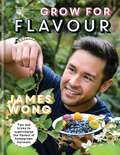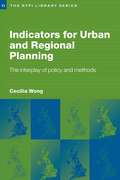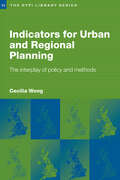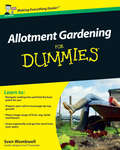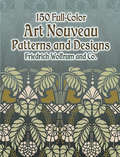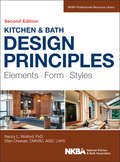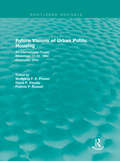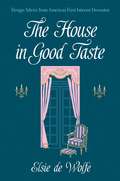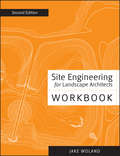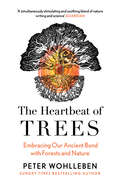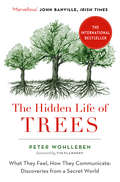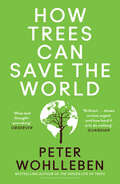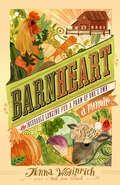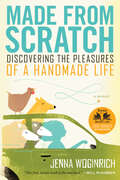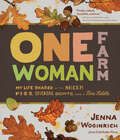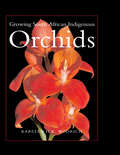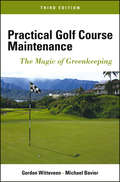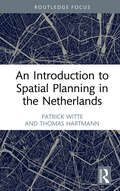- Table View
- List View
RHS Grow for Flavour: Tips & tricks to supercharge the flavour of homegrown harvests
by James Wong The Royal Horticultural SocietyThis ebook edition of RHS Grow for Flavour is best enjoyed on a larger-screen, colour device.'...packed with stats and science cleverly packaged to make it engaging and accessible'.The English GardenHave you ever grown a batch of lovingly nurtured tomatoes only to be disappointed by the flavour when you harvest them? Best-selling gardening writer and botanist James Wong is convinced that the problem lies with current gardening practices which create bumper harvests at the direct expense of flavour. James's solution? Simply by growing the best-flavoured varieties and treating them just a bit meaner, you will not only get harvests with an intense flavour - but also slash the work involved. Combining cutting-edge science with overlooked traditional techniques, this ground-breaking book lays out a series of deceptively simple tips and tricks to measurably increase the flavour of grow-your-own favourites like sweetcorn, strawberries and tomatoes, while at the same time revealing exciting new foodie crops you never knew you could grow. James also provides 40 really simple recipes for delicious ways to eat what you've grown. With James Wong's RHS Grow for Flavour you can halve your labour and double your harvest - and be rewarded with flavour that simply cannot be bought. So what are you waiting for?
Indicators for Urban and Regional Planning: The Interplay of Policy and Methods (RTPI Library Series)
by Cecilia WongThis book focuses on the measurement and utilisation of quantitative indicators in the urban and regional planning fields. There has been a resurgence of academic and policy interest in using indicators to inform planning, partly in response to the current government's information intensive approach to decision-making. The content of the book falls into three broad sections: indicators usage and policy-making; methodological and conception issues; and case studies of policy indicators.
Indicators for Urban and Regional Planning: The Interplay of Policy and Methods (RTPI Library Series)
by Cecilia WongThis book focuses on the measurement and utilisation of quantitative indicators in the urban and regional planning fields. There has been a resurgence of academic and policy interest in using indicators to inform planning, partly in response to the current government's information intensive approach to decision-making. The content of the book falls into three broad sections: indicators usage and policy-making; methodological and conception issues; and case studies of policy indicators.
Allotment Gardening For Dummies
by Sven WombwellAllotment Gardening For Dummies is a lively, hands-on guide to getting the most out of your allotment. Whether you're interested in eating fresh, saving money, getting exercise or enjoying wholesome family fun, this is the guide for you. The step-by-step advice takes you through all the stages in the process, from securing an allotment and preparing your plot, to choosing what to grow and enjoying the benefits of abundant fresh food and a sociable and healthy hobby. With over 50 handy line drawings, plus information on how to grow organic and advice on storing and cooking the food you grow, this guide really does have it all! Allotment Gardening For Dummies includes: Part 1: Getting to Grips with Allotment Gardening Chapter 1: What Are Allotments All About? Chapter 2: Getting hold of an Allotment Chapter 3: Getting Started Part 2: Preparing for Allotment Success Chapter 4: Deciding What to Grow, When Chapter 5: Preparing Your Plot Chapter 6: Keeping Your Soil Healthy Chapter 7: Keeping Your Plants Healthy Chapter 8: Growing Organic Part 3: Growing a Few of Your Favourite Vegetables Chapter 9: Going Underground Chapter 10: The Staples Chapter 11: Growing Leafy Greens Chapter 12: Planting Peas, Beans and Other Pods Chapter 13: Growing More Exotic Veg Part 4: Extending Your Allotment Repetoire Chapter 14: Growing Wholesome Herbs Chapter 15: Growing Fruitful Fruit Chapter 16: Nurturing Flowers on an Allotment Part 5: Getting the Most Out of Your Allotment Chapter 17: Involving Children Around the Allotment Chapter 18: Hobnobbing with Allotment Society Chapter 19: Growing Giant Veg Part 6: The Part of Tens Chapter Chapter 20: Ten Common Accidents and How to Prevent Them Chapter 21: Ten Ways to Revive a Flagging Allotment
Allotment Gardening For Dummies
by Sven WombwellAllotment Gardening For Dummies is a lively, hands-on guide to getting the most out of your allotment. Whether you're interested in eating fresh, saving money, getting exercise or enjoying wholesome family fun, this is the guide for you. The step-by-step advice takes you through all the stages in the process, from securing an allotment and preparing your plot, to choosing what to grow and enjoying the benefits of abundant fresh food and a sociable and healthy hobby. With over 50 handy line drawings, plus information on how to grow organic and advice on storing and cooking the food you grow, this guide really does have it all! Allotment Gardening For Dummies includes: Part 1: Getting to Grips with Allotment Gardening Chapter 1: What Are Allotments All About? Chapter 2: Getting hold of an Allotment Chapter 3: Getting Started Part 2: Preparing for Allotment Success Chapter 4: Deciding What to Grow, When Chapter 5: Preparing Your Plot Chapter 6: Keeping Your Soil Healthy Chapter 7: Keeping Your Plants Healthy Chapter 8: Growing Organic Part 3: Growing a Few of Your Favourite Vegetables Chapter 9: Going Underground Chapter 10: The Staples Chapter 11: Growing Leafy Greens Chapter 12: Planting Peas, Beans and Other Pods Chapter 13: Growing More Exotic Veg Part 4: Extending Your Allotment Repetoire Chapter 14: Growing Wholesome Herbs Chapter 15: Growing Fruitful Fruit Chapter 16: Nurturing Flowers on an Allotment Part 5: Getting the Most Out of Your Allotment Chapter 17: Involving Children Around the Allotment Chapter 18: Hobnobbing with Allotment Society Chapter 19: Growing Giant Veg Part 6: The Part of Tens Chapter Chapter 20: Ten Common Accidents and How to Prevent Them Chapter 21: Ten Ways to Revive a Flagging Allotment
How To Grow Fresh Air: 50 Houseplants To Purify Your Home Or Office
by Dr B.C. WolvertonAn illustrated guide to the houseplants you need for clean and fresh air when you're stuck at homeHow clean is the air you breathe? Plants are the lungs of the earth: they produce the oxygen that makes life possible, add precious moisture and filter toxins. Houseplants can perform these essential functions in your home or office with the same efficiency as a rainforest in our biosphere. In this beautifully illustrated guide, noted scientist Dr Bill Wolverton shows you how to grow 50 plants that filter the most common pollutants, making it easy for you to purify the environments that impact you the most.
150 Full-Color Art Nouveau Patterns and Designs (Dover Pictorial Archive)
by Friedrich Wolfrum Co.The novelty of Art Nouveau derived in part from its innovative approach to the very concept of art. More than just a style, it eliminated the barriers between fine and applied arts and embodied a new way of thinking about modern society and production methods. Art Nouveau attempted nothing less than the redefinition of the meaning and nature of art.This multipurpose treasury features luxuriant patterns and designs that date from the early twentieth century, the heyday of Art Nouveau. Featuring both allover patterns and stand-alone designs, it consists of 49 full-page illustrations, plus eleven pages with numerous individual images. Handsomely reproduced from a rare Viennese publication, this inexpensive volume offers a sumptuous assortment of authentic designs from a revolutionary art movement.
Kitchen and Bath Design Principles: Elements, Form, Styles (NKBA Professional Resource Library)
by Nancy Wolford Ellen Cheever NKBA (National Kitchen and Bath Association)The industry standard, full-color guide to practical kitchen and bath design Kitchen and Bath Design Principles is The National Kitchen and Bath Association's complete guide to uniting function and style in these important rooms. This full-color guide is heavily illustrated, with a revised layout and graphic design that presents information more clearly for visual learners. The updated second edition has been expanded to adhere more closely to the standards of interior design, including new information on unity, proportion, scale, and variety, plus a new glossary to clarify unfamiliar terms. Stylistic themes remain a major component, with emphasis on the architecture, furniture, styles, and fashions of each era, and all technical and aesthetic information is presented in clear, concise language. The companion website features a teacher's guide and image bank that facilitate use in the classroom, providing additional examples of design principles in action. The National Kitchen and Bath Association established the standard guidelines for safe and effective kitchen and bath design, and this book is the complete guide to incorporating code and aesthetics from the very beginning. Function is just as important as style in these rooms, so Kitchen and Bath Design Principles teaches readers to: Apply the elements and principles of design to real-life situations Discover how best to apply the tools of design in daily business practice Explore the global and cultural influences reflected in popular stylistic themes Translate the aesthetics of an era into a workable theme for a kitchen or bath To best serve clients, designers must learn to meet all codes, regulations, and expectations with a balance of substance and style. Kitchen and Bath Design Principles is the industry standard reference, from the industry-leading provider of kitchen and bath design education.
Kitchen and Bath Design Principles: Elements, Form, Styles (NKBA Professional Resource Library)
by Nancy Wolford Ellen Cheever NKBA (National Kitchen and Bath Association)The industry standard, full-color guide to practical kitchen and bath design Kitchen and Bath Design Principles is The National Kitchen and Bath Association's complete guide to uniting function and style in these important rooms. This full-color guide is heavily illustrated, with a revised layout and graphic design that presents information more clearly for visual learners. The updated second edition has been expanded to adhere more closely to the standards of interior design, including new information on unity, proportion, scale, and variety, plus a new glossary to clarify unfamiliar terms. Stylistic themes remain a major component, with emphasis on the architecture, furniture, styles, and fashions of each era, and all technical and aesthetic information is presented in clear, concise language. The companion website features a teacher's guide and image bank that facilitate use in the classroom, providing additional examples of design principles in action. The National Kitchen and Bath Association established the standard guidelines for safe and effective kitchen and bath design, and this book is the complete guide to incorporating code and aesthetics from the very beginning. Function is just as important as style in these rooms, so Kitchen and Bath Design Principles teaches readers to: Apply the elements and principles of design to real-life situations Discover how best to apply the tools of design in daily business practice Explore the global and cultural influences reflected in popular stylistic themes Translate the aesthetics of an era into a workable theme for a kitchen or bath To best serve clients, designers must learn to meet all codes, regulations, and expectations with a balance of substance and style. Kitchen and Bath Design Principles is the industry standard reference, from the industry-leading provider of kitchen and bath design education.
Future Visions of Urban Public Housing: An International Forum, November 17-20, 1994 (Routledge Revivals)
by Wolfgang F.E. Preiser David P. Varady Francis P. RussellFirst published in 1994, this book brings together the papers presented at the International Forum on ‘Future Visions of Urban Public Housing’ held on November 17-20, 1994 in Cincinnati, Ohio. Participants included public housing officials, academics, practitioners and public housing residents who came together to debate, compare and analyse practices and issues in urban and public housing in industrialised nations. The 55 collected papers address the following key topics: public housing policy; comprehensive neighbourhood planning for public housing; public housing in the urban design context; quality of design standards and guidelines for public housing; resident participation and enhanced self-sufficiency in public housing; public housing alternatives; revitalising and rehabilitating public housing; the Elderly, Children, and special populations in public housing. The findings suggest new directions for policy and agendas for action.
The House in Good Taste: Design Advice from America's First Interior Decorator (Dover Architecture)
by Elsie De Wolfe"Good taste can be developed in anyone, just as surely as good manners are possible to anyone. And good taste is as necessary as good manners," declared Elsie de Wolfe, the "first lady" of American interior design. Although de Wolfe decorated the homes of wealthy, socially prominent clients, she always maintained that her vision of elegant but comfortable living is attainable to all. This timeless 1913 book, written in a friendly, conversational tone, explains how to design, furnish, and decorate a house in order to make it a beautiful, useful, and livable home.De Wolfe pioneered the concept of the home as a representation of the owner's identity, and this book defines her decorating methods, philosophy, and approach to creating spaces for gracious entertaining. Part step-by-step manual and part aesthetic treatise, this volume advocates for simpler yet more refined decor. In contrast to the Victorian penchant for dark furniture, bric-a-brac, and heavy draperies, de Wolfe advised her readers to let in natural light, to replace gaudy colors with beige and ivory, and to abandon clutter. Her practical suggestions, illustrated by period photographs, illuminate the attitudes of a century ago while retaining their resonance for modern-day interior designers.
Site Engineering Workbook
by Jake WolandA study guide to help you master the principles and practices of site engineering Whether used in conjunction with the Sixth Edition of Site Engineering for Landscape Architects or on its own, this Workbook is an invaluable learning resource for students and instructors, as well as for professionals studying for the LARE and other licensing exams. Organized into chapters that correspond with those in the textbook, the Workbook offers: Practice questions, problems, and review exercises designed to reinforce site engineering concepts Site and grading diagrams that make it possible to apply site engineering concepts in a practical way Four types of questions—observations, short answer, long answer, and graphic exercises—that offer opportunities to approach the material from varied angles and levels of complexity Answers to workbook problems, provided online via an instructor's site Designed for the needs of both students and professionals, this Workbook makes it easier than ever for you to quickly master the principles and practices involved in today's environmentally sound site engineering.
Site Engineering Workbook
by Jake WolandA study guide to help you master the principles and practices of site engineering Whether used in conjunction with the Sixth Edition of Site Engineering for Landscape Architects or on its own, this Workbook is an invaluable learning resource for students and instructors, as well as for professionals studying for the LARE and other licensing exams. Organized into chapters that correspond with those in the textbook, the Workbook offers: Practice questions, problems, and review exercises designed to reinforce site engineering concepts Site and grading diagrams that make it possible to apply site engineering concepts in a practical way Four types of questions—observations, short answer, long answer, and graphic exercises—that offer opportunities to approach the material from varied angles and levels of complexity Answers to workbook problems, provided online via an instructor's site Designed for the needs of both students and professionals, this Workbook makes it easier than ever for you to quickly master the principles and practices involved in today's environmentally sound site engineering.
The Heartbeat of Trees
by Peter WohllebenFROM THE AUTHOR OF THE SUNDAY TIMES BESTSELLER, THE HIDDEN LIFE OF TREES ‘A simultaneously stimulating and soothing blend of nature writing and science … Strongly encourages tree hugging for our own, human sake’ Guardian Summer Reads 2021
The Hidden Life of Trees: What They Feel, How They Communicate - Discoveries From A Secret World
by Peter WohllebenSunday Times Bestseller ‘A paradigm-smashing chronicle of joyous entanglement’ Charles Foster Waterstones Non-Fiction Book of the Month (September) Are trees social beings? How do trees live? Do they feel pain or have awareness of their surroundings?
How Trees Can Save the World
by null Peter WohllebenFrom the internationally bestselling author of The Hidden Life of Trees An illuminating manifesto on ancient forests: how they adapt to climate change by passing their wisdom through generations, and why our future lies in protecting them. In his beloved book The Hidden Life of Trees, Peter Wohlleben revealed astonishing discoveries about the social networks of trees and how they communicate. Now, in The Power of Trees, he turns to their future, with a searing critique of forestry management, tree planting and the exploitation of old growth forests. As human-caused climate change devastates the planet, forests play a critical role in keeping it habitable. While politicians and business leaders would have us believe that cutting down forests can be offset by mass tree planting, Wohlleben offers a warning: many tree planting schemes lead to ecological disaster. Not only are these trees more susceptible to disease, flooding, fires and landslides, we need to understand that forests are more than simply a collection of trees. Instead, they are ecosystems that consist of thousands of species, from animals to fungi and bacteria. The way to save trees, and ourselves? Step aside and let forests – which are naturally better equipped to face environmental challenges – heal themselves. With the warmth and wonder familiar to readers from his previous books, Wohlleben also shares emerging scientific research about how forests shape climates both locally and across continents; that trees adapt to changing environmental conditions through passing knowledge down to their offspring; and how old growth may in fact have the most survival strategies for climate change. At the heart of The Power of Trees lies Wohlleben's passionate plea: that our survival is dependent on trusting ancient forests and allowing them to thrive.
Barnheart: The Incurable Longing for a Farm of One's Own
by Jenna WoginrichA laugh-out-loud funny, and yet often poignant, memoir about a young woman&’s quest for a farm of her own and her challenges in finding a permanent home for herself and her animals.
Made from Scratch: Discovering the Pleasures of a Handmade Life
by Jenna WoginrichIn a hectic world of mass-produced food, clothing, and entertainment, it&’s easy to miss out on the simple pleasures of doing things for yourself. Young web designer Jenna Woginrich chronicles her adventures as she learns to embrace the idea of self-sufficiency in all aspects of her life, including sewing her own clothes, growing her own food, and creating her own fun outside of the mainstream. Woginrich&’s hilarious, heartbreaking, and soul-satisfying journey will bring joy and inspiration to those who dream about a more independent lifestyle.
One-Woman Farm: My Life Shared with Sheep, Pigs, Chickens, Goats, and a Fine Fiddle
by Jenna WoginrichPopular blogger and first-time farmer Jenna Woginrich shares the spirit and experiences of living close to the land at Cold Antler Farm.
Growing South African Indigenous Orchids
by Karsten WodrichProviding a guide to the cultivation of both the terrestrial and epihytic orchid species growing in South Africa, this volume includes numerous hints, illustrations and photographs to help simplify the process. Detailed growing notes are given for over 60 terrestrial and over 40 epiphytic species.
Growing South African Indigenous Orchids
by Karsten WodrichProviding a guide to the cultivation of both the terrestrial and epihytic orchid species growing in South Africa, this volume includes numerous hints, illustrations and photographs to help simplify the process. Detailed growing notes are given for over 60 terrestrial and over 40 epiphytic species.
Practical Golf Course Maintenance: The Magic of Greenkeeping
by Gordon Witteveen Michael BavierThe revised, bestselling resource of practical, nontechnical advice for maintaining and operating a golf course Practical Golf Course Maintenance, Third Edition presents the latest information and techniques for providing first-rate upkeep and management operations for any golf course. This book's, clear, step-by-step coverage, unencumbered by technical language, includes critical advice on maintaining consistent bunkers, sand top-dressing and aerifying, pesticide storage, and other emerging technologies, as well as mowing techniques for greens, fairways, and tees—and much more! This updated Third Edition offers reliable, state-of-the-art guidance and hundreds of helpful tips with: Major revisions throughout to address the latest information on computer- operated irrigation systems, new equipment for all aspects of course maintenance, water quality and conservation issues, and managing people A clear approach that avoids technical language and scientific citations while delivering practical advice that can be immediately applied on the course Coverage of all aspects of course maintenance from tee to green, along with guidance on managing the course for the rules of the game and managing the business aspects of course management and maintenance Practical Golf Course Maintenance, Third Edition is a valuable tool for golf course owners, architects, builders, golfers, golf professionals, club managers, and superintendents, as well as greens committee members, irrigation specialists, field managers, turfgrass specialists, real estate developers, and landscape architects.
Practical Golf Course Maintenance: The Magic of Greenkeeping
by Gordon Witteveen Michael BavierThe revised, bestselling resource of practical, nontechnical advice for maintaining and operating a golf course Practical Golf Course Maintenance, Third Edition presents the latest information and techniques for providing first-rate upkeep and management operations for any golf course. This book's, clear, step-by-step coverage, unencumbered by technical language, includes critical advice on maintaining consistent bunkers, sand top-dressing and aerifying, pesticide storage, and other emerging technologies, as well as mowing techniques for greens, fairways, and tees—and much more! This updated Third Edition offers reliable, state-of-the-art guidance and hundreds of helpful tips with: Major revisions throughout to address the latest information on computer- operated irrigation systems, new equipment for all aspects of course maintenance, water quality and conservation issues, and managing people A clear approach that avoids technical language and scientific citations while delivering practical advice that can be immediately applied on the course Coverage of all aspects of course maintenance from tee to green, along with guidance on managing the course for the rules of the game and managing the business aspects of course management and maintenance Practical Golf Course Maintenance, Third Edition is a valuable tool for golf course owners, architects, builders, golfers, golf professionals, club managers, and superintendents, as well as greens committee members, irrigation specialists, field managers, turfgrass specialists, real estate developers, and landscape architects.
An Introduction to Spatial Planning in the Netherlands
by Patrick Witte Thomas HartmannThis book provides an introduction to spatial planning in the Netherlands. It explores the academic underpinnings of the discipline and its practical implications, making use of insights on planning practices from the Netherlands. As an academic book with relevance for spatial planning teaching and practice, the relation between planning practice and planning as an academic discipline are discussed. A key analytical concept is introduced to discuss the different dimensions of planning: the planning triangle. This framework helps to bridging the strategic and conceptual elements of planning with its realization. The object, process and context of planning and its relations are discussed. The core of the academic discipline and profession of spatial planning entails looking (far) into the future, stimulating discussion, formulating a desired future direction through an informal and collective planning process and then formalizing and placing current action into that future perspective. In that sense, spatial planning can be understood as the strategic organisation of hopes and expectations. As a study book it is suitable for students of planning at various universities, but also for students in higher professional education. For those involved in the professional field of spatial planning, this book offers a sound foundation.
An Introduction to Spatial Planning in the Netherlands
by Patrick Witte Thomas HartmannThis book provides an introduction to spatial planning in the Netherlands. It explores the academic underpinnings of the discipline and its practical implications, making use of insights on planning practices from the Netherlands. As an academic book with relevance for spatial planning teaching and practice, the relation between planning practice and planning as an academic discipline are discussed. A key analytical concept is introduced to discuss the different dimensions of planning: the planning triangle. This framework helps to bridging the strategic and conceptual elements of planning with its realization. The object, process and context of planning and its relations are discussed. The core of the academic discipline and profession of spatial planning entails looking (far) into the future, stimulating discussion, formulating a desired future direction through an informal and collective planning process and then formalizing and placing current action into that future perspective. In that sense, spatial planning can be understood as the strategic organisation of hopes and expectations. As a study book it is suitable for students of planning at various universities, but also for students in higher professional education. For those involved in the professional field of spatial planning, this book offers a sound foundation.
